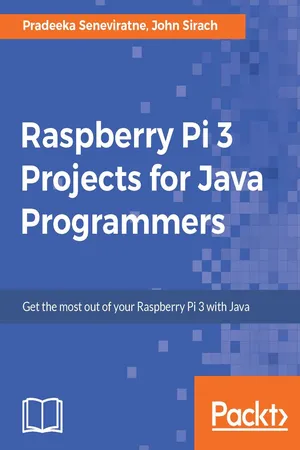
- 286 pages
- English
- ePUB (mobile friendly)
- Available on iOS & Android
Raspberry Pi 3 Projects for Java Programmers
About this book
Learn the art of building enticing projects by unleashing the potential of Raspberry Pi 3 using JavaAbout This Book• Explore the small yet powerful mini computer in order to run java applications• Leverage Java libraries to build exciting projects on home automation, IoT, and Robotics by leveraging Java libraries• Get acquainted with connecting electronic sensors to your Raspberry Pi 3 using Java APIs.Who This Book Is ForThe book is aimed at Java programmers who are eager to get their hands-on Raspberry Pi and build interesting projects using java. They have a very basic knowledge of Raspberry Pi.What You Will Learn• Use presence detection using the integrated bluetooth chip• Automatic light switch using presence detection• Use a centralized IoT service to publish data using RPC• Control a robot by driving motors using PWM• Create a small web service capable of performing actions on the Raspberry Pi and supply readings• Image capture using Java together with the OpenCV frameworkIn DetailRaspberry Pi is a small, low cost and yet very powerful development platform. It is used to interact with attached electronics by the use of it's GPIO pins for multiple use cases, mainly Home Automation and Robotics.Our book is a project-based guide that will show you how to utilize the Raspberry Pi's GPIO with Java and how you can leverage this utilization with your knowledge of Java. You will start with installing and setting up the necessary hardware to create a seamless development platform. You will then straightaway start by building a project that will utilize light for presence detection. Next, you will program the application, capable of handling real time data using MQTT and utilize RPC to publish data to adafruit.io. Further, you will build a wireless robot on top of the zuma chassis with the Raspberry Pi as the main controller. Lastly, you will end the book with advanced projects that will help you to create a multi-purpose IoT controller along with building a security camera that will perform image capture and recognize faces with the help of notifications.By the end of the book, you will be able to build your own real world usable projects not limited to Home Automation, IoT and/or Robotics utilizing logic, user and web interfaces.Style and approachThe book will contain projects that ensure a java programmer gets started with building interesting projects using the small yet powerful Raspberry Pi 3. We will start with brushing up your Raspberry Pi skills followed by building 5-6 projects
Frequently asked questions
- Essential is ideal for learners and professionals who enjoy exploring a wide range of subjects. Access the Essential Library with 800,000+ trusted titles and best-sellers across business, personal growth, and the humanities. Includes unlimited reading time and Standard Read Aloud voice.
- Complete: Perfect for advanced learners and researchers needing full, unrestricted access. Unlock 1.4M+ books across hundreds of subjects, including academic and specialized titles. The Complete Plan also includes advanced features like Premium Read Aloud and Research Assistant.
Please note we cannot support devices running on iOS 13 and Android 7 or earlier. Learn more about using the app.
Information
Integrating a Real-Time IoT Dashboard
- Create feeds and a dashboard with Adafruit IO
- Connect the TMP102 temperature sensor with the Raspberry Pi through an I2C bus
- Get data from the temperature sensor through the I2C with the Pi4J library
- Work with the Eclipse Paho Java MQTT client library
- Publish data to the feed on a specific topic
- Display data on the Adafruit IO dashboard
- Subscribe to a feed to get data on a specific topic
- Control an actuator using the Adafruit IO dashboard
Adafruit IO
- Arduino
- Ruby
- Python
- Node.js
Bill of materials
- One Raspberry Pi 3 (SparkFun part number: DEV-13825)
- One SparkFun digital temperature sensor breakout board - TMP102 (SparkFun part number: SEN-11931)
- One LED
- One breadboard-self-adhesive (white) (SparkFun part number: PRT-12002)
- Hookup wire or jumper wire kit
- Wire strippers
Sign in with Adafruit IO
- Using your web browser, visit https://io.adafruit.com/ and click the large text button, SIGN IN TO JOIN THE OPEN BETA.
- On the next page, there are two options available for you. If you already have an account with Adafruit, you can use the same credentials to sign in with Adafruit IO by giving the credentials (email/username and password) and clicking on the SIGN IN button. If you don't have an account, click the SIGN UP button to create a new account.

- A navigation menu is located on the left-hand side of the page, and provides links to your profile, feeds, groups, dashboards, triggers, and settings.
Finding your AIO key
- In the left navigation bar of the dashboards page, click the Settings menu. You will navigate to the Settings page with a set of settings associated with your Adafruit IO account, as shown in Figure 4-2:

- Click VIEW AIO KEY under Manage AIO Keys. A pop-up window will show the AIO key associated with your account, as shown in Figure 4-3:

c62d5f647eb44a4098ff0c46403b...Table of contents
- Title Page
- Copyright
- Credits
- Foreword
- About the Authors
- www.PacktPub.com
- Customer Feedback
- Preface
- Setting up Your Raspberry Pi
- Automatic Light Switch Using Presence Detection
- A Social and Personal Digital Photo Frame
- Integrating a Real-Time IoT Dashboard
- Wireless Controlled Robot
- Building a Multipurpose IoT Controller
- Security Camera with Face Recognition